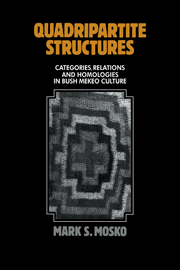Book contents
- Frontmatter
- Contents
- List of figures, tables, and maps
- Preface
- 1 Introduction: the problem and the people
- 2 Between village and bush
- 3 Body and cosmos
- 4 Sex, procreation, and menstruation
- 5 Male and female
- 6 Kin, clan, and connubium
- 7 Feasts of death (i): de-conception and re-conception
- 8 Feasts of death (ii): the sons of Akaisa
- 9 Tikopia and the Trobriands
- 10 Conclusions: indigenous categories, cultural wholes, and historical process
- Appendixes
- Notes
- Bibliography
- Index
4 - Sex, procreation, and menstruation
Published online by Cambridge University Press: 04 August 2010
- Frontmatter
- Contents
- List of figures, tables, and maps
- Preface
- 1 Introduction: the problem and the people
- 2 Between village and bush
- 3 Body and cosmos
- 4 Sex, procreation, and menstruation
- 5 Male and female
- 6 Kin, clan, and connubium
- 7 Feasts of death (i): de-conception and re-conception
- 8 Feasts of death (ii): the sons of Akaisa
- 9 Tikopia and the Trobriands
- 10 Conclusions: indigenous categories, cultural wholes, and historical process
- Appendixes
- Notes
- Bibliography
- Index
Summary
Bush Mekeo views of human sexuality and reproduction are closely tied to conceptualizations of the spatiotemporal order and the indigenous theories concerning food, blood synthesis, excretion, health, and illness. Conception, for example, involves transfers in and out of bodies and transformations between sweet and unsweet as well as the distinction between clean and dirty. Also, babies are conceived in the abdomens of their mothers. However, the processes of sexuality and reproduction as the Bush Mekeo know them seem initially to contradict the relations between the categories I have revealed in the contexts previously described. Oral ingestion of any hot bloody dirt is said to lead to illness and even death. Semen is one such poison and will produce the same undesired result if it is eaten. Yet, semen ingested by a woman in sexual intercourse may well have the exact opposite effect; that is, it can result in the conceiving of a child or new life, rather than illness or death. This is one further way dirt, at least in the form of male semen, may paradoxically sustain the life of a body, much as may food, even though the two are categorically opposed in the context of eating. Furthermore, the native understanding of menstruation is implicated in this particular contradiction. According to villager claims, women will not menstruate spontaneously but only as a result of sexual intercourse.
This chapter attempts to clarify these issues and resolve the apparent contradictions among them by articulating the explicit ideological tenets of the indigenous theory of human procreation.
- Type
- Chapter
- Information
- Quadripartite StructuresCategories, Relations and Homologies in Bush Mekeo Culture, pp. 60 - 72Publisher: Cambridge University PressPrint publication year: 1985



